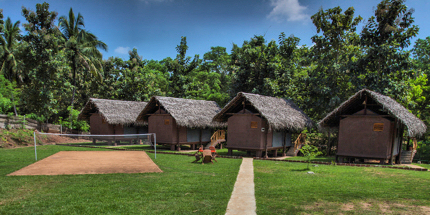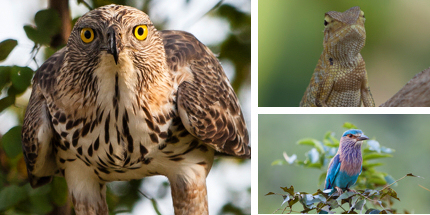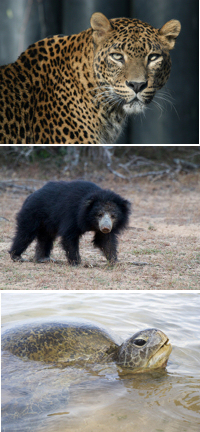On safari in Sri Lanka
Enjoy a jungle glamping safari holiday in Sri Lanka where abundant elephants mean you don’t have to wait long to get close to the wildlife, says Hanna Lindon.
An elephant was blocking the road. She rolled a leisurely eye at the safari truck and then shuffled round to present us with her dusty behind.
“Look there,” said our guide excitedly. “See – she has a baby!”
We craned forward, just in time to see a pint-sized trunk and a curious pair of eyes emerge from between the mother elephant’s back legs. This tiny little fellow couldn’t have been more than a few days old; a fluffy-headed, gangly little miracle that had everybody in the truck cooing with pure joy.
We were at the start of a safari drive around Udawalawe National Park in the steamy heart of southern Sri Lanka. This ethereal landscape of lush plains and open water is one of the best places in the world to see elephants – better even than many parts of Africa. If you haven’t heard of it, that’s only because the 26-year civil war turned much of the country into a virtual no-go zone for tourists. Since the war ended in 2009, however, national parks like Udawalawe and Yala have begun to cultivate a boutique safari scene that’s attracting travellers from all around the planet.
Jungle camp
Athgira River Camp on the southernmost tip of Udawalawe Reservoir is one of the many lodges that have sprung up on the fringes of the national park over the past few years. It’s a true tropical hideaway; a rustic collection of four grass-roofed, glamping-style cabanas with canvas walls overlooking the Rakwana River and surrounded by riotous palm trees.
 Stay in glamping-style jungle cabanas
Stay in glamping-style jungle cabanas Guy Prince
This little jungle camp is still a well-kept secret. It tends to attract mainly Sri Lankan families, although our tent neighbours were a friendly German couple. Guests are cosseted with butler service and scrumptious food grown in the nearby farm garden, while retaining a close connection with the great outdoors.
We checked in at midday, sweaty and dishevelled after a nail-biting bus ride from Colombo, and headed straight for the natural swimming area created by a lazy meander in the river. A group of Sri Lankan women were washing their clothes further downstream; they smiled and giggled at us as we splashed around in the shady shallows. This wasn’t the usual sterile swimming pool experience that I associate with fortress-style African lodges. We were mingling with the locals rather than being barricaded away behind electric fences, and it felt much more immersive in consequence.
Into the wild
By the time we tore ourselves away from the river, the day had turned from lukewarm to seriously sweltering. Draped in loose kafkans and floppy hats, we climbed aboard the safari truck and sped along the fringes of the reservoir towards the gates of the national park.
Elephants were top of our to-see list – but Udawalawe is also home to leopards, sloth bears, samba deer, water buffalo, wild boar, the odd croc, not to mention a natural aviary of tropical birds. “Sometimes there is much to see,” he said. “But sometimes, nothing at all.”
 A crested hawk eagle, lizard and roller bird
A crested hawk eagle, lizard and roller birdGuy Prince
We were in luck. Thirty seconds after passing through the park gates, we spied our first elephant – the mother with her tiny baby. There are thought to be around 250 elephants roaming Udawalawe, but there’s a constant stream of new arrivals, thanks to the Elephant Transit Home, a project that releases abandoned, injured or orphaned elephants into the park. The relatively small size of the national park – it spans 31,000 hectares (76,602 acres) - also makes this endangered species easier to spot.
Our guide knew exactly where to find the largest herds – within an hour, we’d seen babies wallowing in waterholes, family groups showering one another with much joyful trumpeting, and a giant lone male who wafted his ears threateningly in the direction of our truck.
A colourful sideshow was provided by flocks of stunning birds, including hornbills, kingfisher, painted storks and fish eagles. As the sun began to sink below the trees, we even saw a great croc sliding back into the murky reservoir.
Tropical nights
Back at the lodge, our 24-hour on-call butler had been busy. A smorgasbord of meaty treats was sizzling away on the barbecue and a candlelit outdoor restaurant had appeared outside our cabana.
As we sat down to sip glasses of fresh pineapple and papaya juice, there was an unearthly noise overhead. “Is okay,” our softly-spoken butler reassured us. “Is only flying foxes travelling to their feeding grounds.”
Eating a juicy barbecued dinner while clouds of hundred-strong flying foxes swooped through the starry sky above and fireflies danced around the clearing was truly magical.
Our enchanting lodge and its wildlife-rich park are still relatively undiscovered compared to the large-scale tourism factory that is the African safari business. But with so much to see and experience, it can’t stay that way for long.
Best of the rest: other national parks in Sri Lanka
 Rich in wildlife
Rich in wildlifeiStockphoto / Thinkstock & Creative Commons / YusufIJsseldijk
YALA: The most popular park in Sri Lanka, this is a top leopard-spotting territory. Samba, buffalo, wild pig and monkeys are also in evidence here.
SINHARJA RAINFOREST RESERVE: Home to the country’s only area of virgin rainforest, this is a prime bird-twitching destination. Look for endemic species such as the red-faced malkoha, green-billed coucal and Sri Lankan blue magpie.
WILPATTU: The sloth bear is one of Sri Lanka shyest critters, but this is the place to try and see one. Muntjac, barking deer and leopards are also abundant.
BUNDALA: This UNESCO biosphere reserve is an important wintering ground for migratory water birds. Enjoy huge flocks of flamingo, waterfowl, cormorants and storks.
REWAKA: This turtle-watching sanctuary is most active between January and July, when an average of 17 turtles per night come on shore to lay their eggs.
NEED TO KNOW
Getting there: Sri Lanka Airlines and British Airways both offer regular flights from London to Colombo from £480pp return. A night’s full-board stay at Athgira River Camp for two people starts from US$90 per night, excluding game drives and national park entry fee.
More information: www.srilanka.travel
Do you have any Feedback about this page?
© 2025 Columbus Travel Media Ltd. All rights reserved. No part of this site may be reproduced without our written permission, click here for information on Columbus Content Solutions.









 You know where
You know where